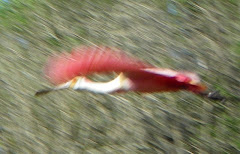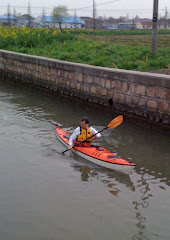Wednesday evening I gave a slide presentation at the WAKE kayak club (at Bellingham Wa) about kayaking in the Faroe Islands. (“They said the Faroes were in Egypt”.) I  was sad to hear of a local paddler who died recently. He was a member of the paddling community if not of that club. WAKE is very safety aware and so everyone took note to see what could be learned.
was sad to hear of a local paddler who died recently. He was a member of the paddling community if not of that club. WAKE is very safety aware and so everyone took note to see what could be learned.
I gathered he was paddling at dusk on a surf-ski, had tipped into the water and become separated from his ski by the wind. By chance another paddler on a surf-ski came by and tried to retrieve his ski for him. He too spilled, and had difficulty climbing back into his seat. By that time in the dark he could see neither the swimmer nor his craft. With his VHF radio he called the rescue services which found the stray kayak but at first could not see the swimmer. When he was eventually spotted and rescued, it was too late. Sadly he died.
Without going into his situation in detail, I thought I might pick up on a few factors that could be of help to others. I’ll focus on surf-skis although most of the points apply to any kayak. I’ll choose just six; there are many more; please feel free to post your own favorites here.
1. Surf-skis generally float well, don’t swamp, yet are lightweight and are easily blown. They blow away more rapidly than capsized sea kayaks, and often more quickly than you can swim. Race craft built for light weight, they often have little in the way of deck-lines or grab handles, and can be slippery when wet. Consider a tether of some sort so you can keep contact. Some surf-ski paddlers tether their paddle to the ski, so if they keep hold of the paddle they have a way to get to their ski. Wave ski paddlers, riding surf waves, make use of an ankle tether which attaches to the ski so it does not get carried to the beach in event of a spill, and this could work well on a surf-ski too.
2. Especially at this time of year when it gets dark early, an after-work spin could finish after dark. Wear reflective clothing to be visible especially if you should end up swimming. Your head and shoulders will show most. Reflective tape shows up really well if someone is shining a light to look for you. Carry a light and you can signal too. Waterproof headlamps and flashing lights of the kind used by cyclists are good inexpensive options. (for a better option see comment by Reni below)
3. If you’re swimming in windy choppy conditions, the chances are against anyone hearing your calls for help. Carry a marine VHF radio, and learn how to use Channel 16 in case of an emergency. With a radio you may be able see and direct searchers straight to your aid even before they can see you.
4. Wear an appropriate PFD (float-vest). Make sure it's the right size, fits correctly and make sure you’ve fastened it correctly.
5. Wear clothing suitable for where you are going and what you could end up doing. Shorts might seem fine for what you first intend to do, but if you could spill into cold water, or you could end your trip wet and in a chill wind, it’s best to dress for those eventualities. A dry-suit is great, but its insulating properties in water are only as good as what you wear inside it. Check for yourself how warm your clothing actually is from time to time by floating around in the water by the shore after paddling.
6. Finally; a few pointers about strategy. It’s easier to get to shore if you are close to it. It’s usually easiest to paddle straight into the wind. It's harder to control a kayak down-wind. It is much more difficult to turn around, and unstable when you are side-on to the wind and waves. In a tippy kayak your easiest and safest route might be from A to B along a shore directly into the wind. Think about it; you don’t want to fall into the water far from shore with an offshore wind while trying to turn around. You don’t want your first rough-water attempts at climbing back on in deep water to happen when you are by yourself in cold water at dusk. Practice your techniques in a safe place! It’s generally safer to paddle with a companion, and a good idea to tell someone responsible where you are going and when you expect to be back. Figure out your strategy to make it easy to stay alive!
Most safety advice is “common sense” when you think about it, but sometimes you don’t think about it till afterwards. The real skill is anticipating events that might happen and figuring out possible strategies to deal with each of them. Preparation includes gear, skills and awareness, and should also include a “get-out clause” so you can turn around and go home without getting wet whenever you don’t think you have all you need to be safe on a particular outing.
You can find a lot more safety tips in my book "Nigel Foster's Sea Kayaking", Globe Pequot Press.































